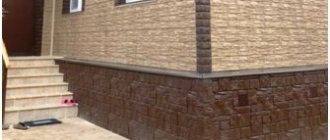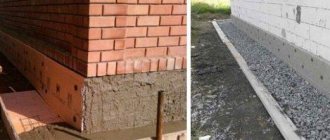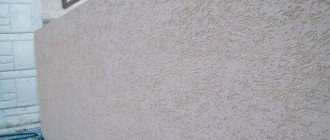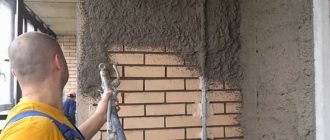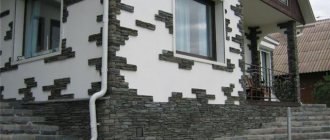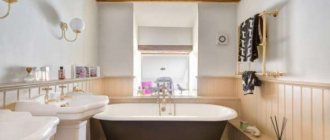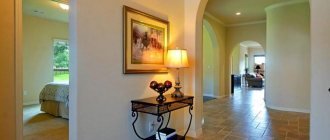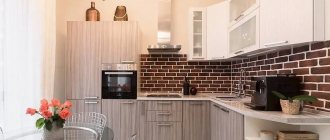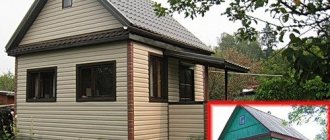When specialists tidy up a house, they pay special attention to finishing the basement.
Depending on the wishes of the customer, it can be a separate component or become one of the components that protrudes to a certain height from the ground. Since this part is in direct contact with the ground, an inexperienced craftsman may have some difficulties associated with the selection of materials and the technique of performing the work. Experts recommend using decorative stones for the basement of a house. Read more: what you need to know about finishing the basement of a private house.
This method has many advantages, but do not forget that to successfully carry out the work you must have skills in the field of construction. You will also have to adhere to a certain order of actions.
The base can be finished with similar material
Advantages of artificial stone for plinths
Artificial stone has been one of the most popular materials for finishing plinths for a long time. This situation is explained not only by the low price of the material, but also by the following advantages:
- When using decorative stone, there is practically no load on the foundation due to the light weight of the elements.
- Easy processing. If the master has a special machine or grinder, he will not have any problems cutting or correcting artificial stone tiles. Due to this advantage, the installation process on the plinth will not be difficult.
- Moisture resistance and durability. Modern artificial stone is made using a technology that makes it no worse than natural material, capable of serving for several decades without replacement.
- Possibility to choose different shapes of any color. This material allows you to beautifully decorate even a country house created according to the most daring design solutions. In this case, a person does not have to spend large sums.
- It is worth paying attention to the fact that thanks to the standard sizes of each tile, the installation process is greatly simplified, since the master will not waste time adjusting the dimensions.
- Another significant advantage is related to the simplicity and ease of installation. When using modern varieties of artificial stones, even an inexperienced person in this matter can install them. Thus, it is not at all necessary to resort to the help of highly qualified specialists. But before you start, it’s worth practicing to make as few mistakes as possible during the laying process.
In this video you will learn more about finishing the base:
What to choose: glue or cement mortar
The traditional technology of cladding the facade and foundation of a house with natural stone with your own hands involves the use of cement-sand mortar. However, as an alternative, a mixture of glue and cement is also used. The industry also produces special frost-resistant mixtures that are characterized by increased elasticity and adhesion. How to properly use substances of this type for finishing the foundation and walls of a house is indicated on the packaging. It should be noted that the use of ready-made mixtures ensures more reliable retention of the stone. Here the technology will also depend on the type of material itself. All stones are usually divided into three categories, differing in the degree of water absorption:
- Low porosity (moisture resistant) - slate, quartzite, dark granite. Due to the small number of pores on the surface of such stones, they are equally suitable for laying on adhesive mixtures and cement mortar.
- Medium-porous stones - black marble, sandstone and light-colored granite. These materials are characterized by an average degree of water absorption. Do-it-yourself installation of them is carried out using a mixture of a light shade or a colorless adhesive composition. In this case, the amount of water should be limited.
- Porous stones - they all do not tolerate moisture well. These rocks include limestone, travertine, thin white granite and white marble. When laying the foundation with your own hands, these stones can only be laid on a dry, light-colored mixture. If you use cement mortar for finishing, it will leave dark traces in the pores, which will then be impossible to remove.
Design features of artificial stone plinth
When creating a design scheme for decorative finishing of a house, you should definitely pay attention to the fact that the external characteristics must be harmoniously combined with other finishing materials for the roof or facade as a whole. This refers to both shade and shape. The use of clear, even lines of artificial stone of the same shape will be the most acceptable solution if the structure is made of brick and some decorative elements of the facade echo the colors of the artificial material as well as its dimensions.
If the house is made of monolithic concrete, it is better to use an asymmetrical arrangement of large parts of the material over the entire surface of the base. At the same time, it is worth paying attention to the fact that imitation cladding with wild gray species goes well with any style trends, as well as modern finishing materials.
Preparatory stage
There are several ways to lay a natural stone foundation.
In any case, pre-clean the surface. Excess dry mortar is removed and the seams are cleaned if the base is brick. The swells on the concrete foundation are cut down. The surface is washed, if necessary, degreased and dried. Primed with concrete contact, applied with a brush, roller or spray gun. It is better to choose a ready-made primer with a coarse-grained fraction, which will increase the adhesion of the finishing material to the surface. Approximate consumption: 250 g. per square meter. Allow 7 hours to dry completely. Operate at temperatures from +5 to +35°C.
Tip: The primer significantly reduces its quality when dust settles on it. Therefore, they treat the area with which they will directly work. For greater reliability, the base can be covered with a fine metal mesh.
Types of artificial stone
Today on the building materials market you can find a large number of different options for artificial finishing of the base. In order to have an idea of which material to give preference to, it is necessary to select it even before the final project of the finished house is drawn up. This will save time and avoid wasting money on materials that will ultimately turn out to be inappropriate.
This is interesting: how to choose an artificial stone for a plinth.
Flexible finishing stone
This is a multilayer composite, produced in the form of solid canvases or individual tiles. Using glue, a fairly thin section of the selected stone is attached to the fabric base. On the inside there is another layer of glue, which is required to secure the tile or canvas to the surface of the base. To protect the material from early drying, it can be covered with paper.
This option will be the lightest in weight when compared with other types of artificial stone. The advantages include flexibility, good resistance to temperature changes and versatility.
Artificial stone made of polymer-sand mixture
This artificial stone is also a composite finishing material. It is made from a special mixture of sand and various polymers used as binders. Another main component is a plasticizer.
This material is one of the types of decorative stone
This artificial stone is made in the form of individual tiles, they are connected to each other by means of locks of certain designs. Fastening to the base or other surfaces of the house occurs using self-tapping screws and a frame. This material can be called quite durable despite the fact that it is not too heavy. It goes well with insulated facades, plinths and other surfaces.
Artificial concrete facing stone
Artificial concrete cladding is considered one of the most popular varieties of this material. It is used for finishing facades, interior walls and plinths not only in private cottages, but also in apartment buildings and public buildings. Manufacturing proceeds as follows:
- First, you will need a silicone, plastic or rubber mold for pouring the solution, which is prepared from high-quality cement, plasticizers, sand, dye and other additives that can improve the properties of the future product.
- Next, depending on the dye and shape used, the appearance and texture of one of the artificial stone types is created. Thus, the output can be one of the most durable, beautiful and durable materials. The only drawback is that the elements of such finishing will be quite heavy.
Clinker facing stone
Due to the production method, this artificial stone resembles in appearance that which is made on a cement base. The most important difference is that it is created from clay.
When compared with other varieties, clinker tiles can be called one of the highest quality materials in terms of performance characteristics. The home owner should be prepared to spend a considerable amount of money.
Homemade artificial stone
The cheapest option for artificial stone for cladding is considered to be homemade artificial stone. To some extent, this process is reminiscent of creating decorative plaster for a base. In this case, it is worth applying a layer of concrete mortar to the surface, on which in the future, using special tools, a finish reminiscent of natural stone will be formed.
To ensure a more realistic effect, it is necessary to take care of the presence of roughness, irregularities and seams between individual elements. The color is imitated using several layers of paint.
Advantages and disadvantages of natural material
Each finishing material has its own advantages and disadvantages, and the facing stone for the base is not without them. The advantages of this product include:
- Durability. The service life is tens of years. Destruction of the coating is observed only if the installation technology is not followed or if the adhesive composition loses its properties.
- Fire resistance. Natural stone for cladding does not contribute to the spread of flame and does not support combustion. In addition, it reliably protects the base from high temperatures. Of course, the safety margin of each variety when heated has its limits. Thus, sandstone begins to crack with prolonged exposure.
- Environmentally friendly. The stone is absolutely safe for human and animal health. It does not release harmful substances or concentrate them from the air. There is an opinion that some types, in particular granite, are radioactive, but this is an exaggeration.
- Moisture resistance. The finishing material does not absorb water and is not destroyed when exposed to it, this ensures durability and facilitates maintenance. But certain varieties require additional protection.
- Visual appeal. Covering the base with natural stone allows you to obtain a decorative coating that is distinguished by its individuality.
Natural stones are not only beautiful, they are also environmentally safe, but experts still recommend checking all natural material for the presence of radioactive background.
Disadvantages cannot be ruled out:
- Expensive. The cost of products depends on the type, but always constitutes a significant part of the budget.
- Difficult to install. Laying a foundation on your own is not easy; you need to take into account many nuances and rules, so doing the work without experience is very problematic. Thus, when using sandstone, a common mistake is not cleaning it, since only washed stone without impurities provides the best adhesion.
One of the indicators of the reliability of the manufacturer and the integrity of the store is the presence of a warehouse where the stone is divided by species and neatly packaged
Finishing the base with artificial stone using tile adhesive
Laying artificial stone with tile adhesive is one of the most common options for cladding a plinth. But first you need to prepare the following tools:
- brush;
- roulette;
- container for water, glue and grout preparation;
- mixer drill with attachment;
- trowel and spatula;
- several brushes;
- syringes for applying grout;
- building level;
- cutting machine.
Don’t forget to prepare the necessary material.
Next, the cladding work involves following the following steps:
- Preparation of the base surface. This work is relevant if significant irregularities are detected. In this case, they must be plastered. Next, you should consistently apply at least two layers of primer, which in the future will ensure good adhesion of the glue to the base surface.
- Preliminary marking. To begin with, it is worth determining which stones will be placed in specific places. At this stage, special attention will have to be paid to the top of the base and the corners. Experienced specialists first lay out artificial stones in the same way in which they will be fixed to the base surface. This will also allow you to check how well they fit together and whether there are any gaps between them. It is also advisable to ensure that there are no significant deviations in the color scheme. All shades should shimmer smoothly.
- Cleaning the inner surface of artificial stone with a brush from cement milk, which has a foamy light layer.
- Production of tile adhesive. To do everything correctly, you must strictly adhere to the recommendations that are written in the instructions on the package. To mix everything well, you should definitely use a mixer. Only in this way will the master be able to obtain a homogeneous composition, which in the future will affect the practicality and durability of the finishing of the base.
- Next, a layer of tile adhesive must be applied to the back side of the artificial stone element using a spatula. Its thickness should be no more than 8-9 mm. At this stage, it is very important not to leave any places on the surface that will not be covered with the composition.
- Now you can carefully attach the artificial stone elements to the base. At the same time, it is better to move it a little in different directions to ensure good adhesion to the base surface. Afterwards, it is necessary to remove excess glue so that it does not remain at the joints between the finishing elements.
Main characteristics of the material
Before purchasing a finishing material, you should familiarize yourself with the technical characteristics. The base requires special attention to the choice of covering, since it is constantly affected by temperature fluctuations and humidity. Artificial stone cladding has the following characteristics:
- Thermal insulation properties. Some types of stone that are produced by humans are distinguished by the presence of air bubbles in the parts, this helps reduce heat loss. If you can’t do without insulation, then choose thermal panels, which consist of insulation, moisture-repellent membranes and synthetic stone.
- Relatively light weight. Compared to natural stone, the decorative counterpart has less weight, which means it does not load the main structure as much.
- Ease of processing. Elements are trimmed and sawed using improvised means.
- Soundproofing. Helps protect the house from the penetration of extraneous noise from the street.
- Fire safety.
- Ease of installation. There are two ways to install artificial stone on a plinth, so everyone chooses the appropriate option. And most importantly, if you strictly follow the instructions, you can do the work yourself.
- Mechanical stability. The base and foundation are constantly exposed to mechanical stress - this includes frozen soil and even impacts. The material made in production perfectly withstands such loads.
- A large selection of shades and patterns that imitate natural material.
- Affordable price. The cost of materials in this category may vary, but it is always lower than for facing bricks or natural stone. Thanks to the wide price range, consumers with different incomes are able to choose the right option.
Finishing the base with artificial stone on the frame
To finish the base on the frame, you first need to try on the prepared panels. Next, you can begin installing the corner panel of the basement siding, as well as the profiles that are necessary for fixing other cladding elements. The left edge of the panel must be trimmed so that it is completely vertical.
Also read: technology for finishing a plinth using stone.
Now it can be installed on the frame. Next, install the second panel, attaching it to the side of the first using a tongue-and-groove lock. Using the same principle, install the remaining panels. If the design involves the presence of any difficult places on the base, the installation of individual parts of artificial elements is carried out here.
